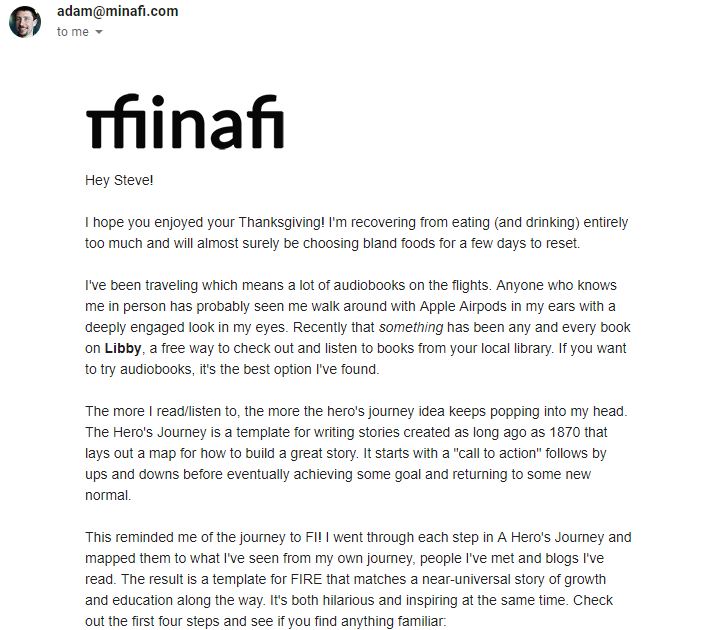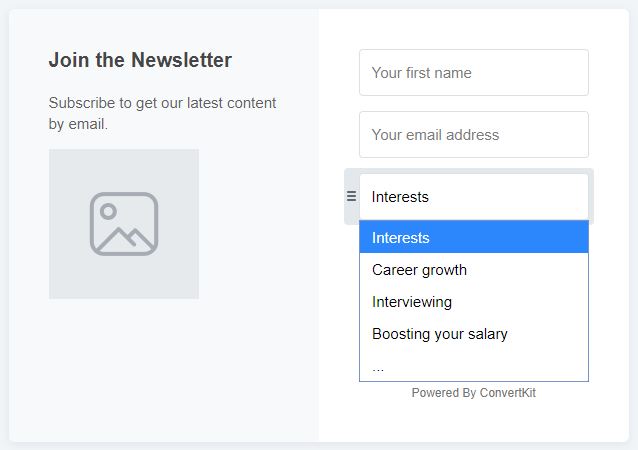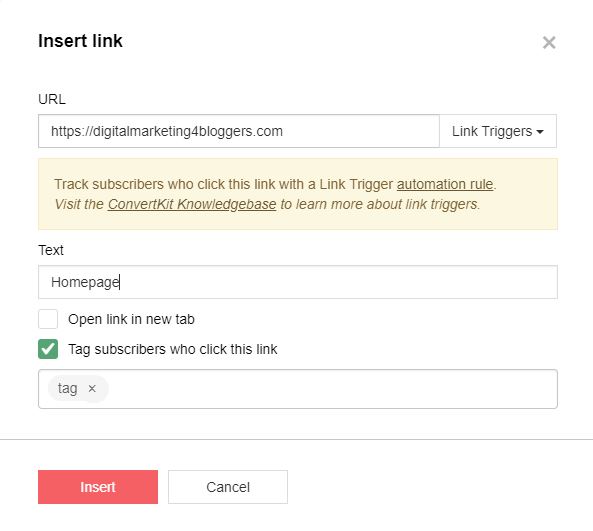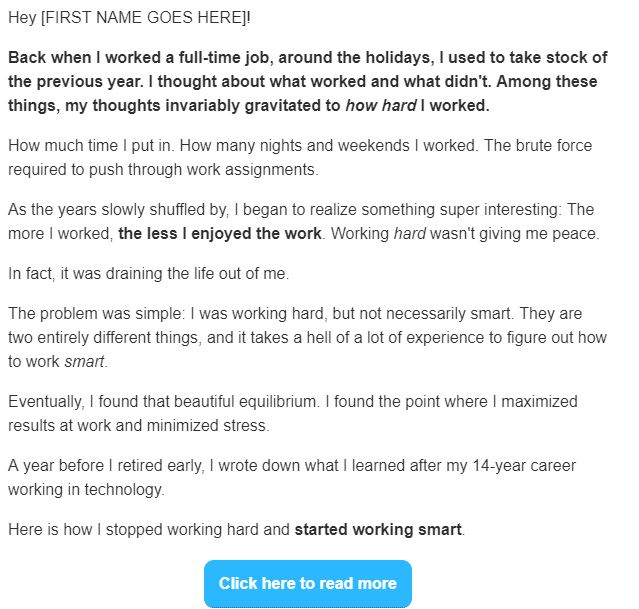Imagine your reader’s inbox. It is probably a mess. It’s filled with all sorts of emails from all sorts of bloggers. Each and every blogger wants that reader’s attention. They want them to click. To buy. To support them in some way.
It might look something like this:

Tell me: What separates your email from the sea of other emails?
Smart bloggers design effective emails that stand out from the pack. Smart bloggers do something different. Write differently. They customize their emails and make them a pleasure to read. Entertaining, even.
Yeah, imagine that!
The more that your email stands out, the more likely the reader will click, read and perform some action (like buy your product or click an affiliate link). Right?
Right. Most of us know this. But, we all don’t know how to make it happen.
Three ways to make your emails stand out
1. Personalize the email with a story
We all get bad emails. In fact, I’d wager that stale, impersonal emails are common in our inbox. They are emails written to appeal to a mass audience. They are salesy. They are uninteresting. We can’t possibly click the ‘Delete’ button fast enough.
Let’s face it: they just suck.
But, most of us have read emails that are the exact opposite, too. These are emails that connect with us. They make us keep reading. We’re interested in what’s coming next – almost like a story. Story-telling is hugely influential.
It’s also one of the best ways to personalize your emails. When we talk to one another, we tend to tell stories. We recall life experiences. We also talk using plain ol’ English. One and two syllable words. Sometimes, three.
And, we often address those whom we are talking to by name. We greet them.
Be a good storyteller and your conversion rates will explode.
Check out this email from investing blog Minafi.com. Begin reading and you’ll quickly realize that this email is just…different. In a good way!

A few things to note:
- It’s primarily text-based, which you know I love.
- The email begins with a personalized greeting (“Hey Steve!”).
- Next, it mentions a recent holiday (Thanksgiving) and the natural tendency to overeat (and drink). This makes the email come across as more honest. Personal. And, way more enjoyable to read.
- The email is a story, and we are lead down a particular path until we get to the end (I only included a small portion of the larger email in this snippet). Good stories keep us invested and interested. They keep us reading.
Though I think this email could be written so it’s more easily scannable (more bold / italicized text, smaller paragraphs, etc), it’s definitely an example of how personalization and storytelling separate our emails from the pack.
2. Target the email
One of the nicest features of most email marketing providers is the ability to use tags and segments to send targeted emails just to those people who are most likely to care. By “care”, we’re talking about a willingness to open the email and read.
If the subscriber cares about your message, they are more likely to open the email, read it and take action. In fact, subscribers are at least 14% more likely to open your email if they were properly segmented. They’re probably interested in the email.
Okay, you get it. Segmenting works. It helps bloggers send the right emails to the right people. Now, let me anticipate your next question.
How can bloggers segment their email list?
There are several ways to segment your email list:
- Ask subscribers to choose interest categories when they sign up (this will require a modification to your opt-in forms). Tag the subscriber with those interests, then design emails that specifically address those topics.
ConvertKit‘s form builder makes this process a synch:

- Re-engage users who signed up for an opt-in incentive. For example, if a subscriber signed up for a PDF download about how to boost their salary at work, they are probably also interested in wealth-building topics.
- Record clicks. ConvertKit allows bloggers to record each click by using link triggers. Tag these users based on the general topic of the link and use those tags to send those subscribers emails with related information.
Link triggers are easy to set up in ConvertKit:

- Build a survey using Google Forms, embed it on your page, and send an email asking your subscribers to take a couple of minutes to fill it out. This will give you a broad overview of what your subscribers most likely want to see.
3. Write, don’t automate
This one is huge, so don’t ignore it. I know instantly whether the email I just got came from an automatic RSS to email system. It’s boxy and dry. The email robotically spits out the post title and the first couple of paragraphs for me to read.
No introduction. No “Hey, Steve!”. No personalization at all.
I can click over to read the rest, but unless that sucker really captures my interest, I don’t click. In fact, I almost never click on an automated RSS to email message. Most of the time, I’ll unsubscribe from the email list, too.
Why?
Because they blogger didn’t take the time to write ME a message to introduce their latest post. They set up their email provider to look for their latest post and throw it out to their entire email list in some one-size-fits-all fashion.
This isn’t smart blogging. It’s not smart digital marketing.
Sorry, but that’s not why I sign up for email lists. If all I wanted was a notification of the blogger’s latest content, I’d use a service like Feedly and save myself the trouble of deleting the emails.
For the record, most email marketing services support creating the RSS to email automation, but I do not recommend using it.
Custom-written emails that sound like a one-on-one conversation perform the best, every time. Bloggers should greet each subscriber by using their name, then introduce their latest content (through a thoughtful story).
The idea is the same: get pageviews. But, the difference is by writing a personalized message to the subscriber, you’re separating your email apart from the other junk in their email box. It doesn’t sound like everybody else’s.
Instead, it reads like the blogger put more effort into writing the email specifically to you rather than automating a mass email to their entire list.
For example, here’s an email I wrote for another blog’s email list:

Notice:
- Yup, it’s all text-based
- I included a customized greeting
- The email includes short, easy-to-read paragraphs
- Important text is bold to improve scannability
- The blue call to action at the bottom is easy to access and click
And best of all, it includes a personalized message. I didn’t just copy the first few paragraphs of the post and slap it into the email. Instead, I wrote a thoughtful message that I hope will resonate with the subscriber.
This will set your email apart from the pack – every time.
4. Talk to your reader
When emails come across as “professionally”-written, buzzword-filled globs of text, I instantly tune out. Instinctively, I feel like I’m being sold something.
I don’t like that, and I bet you don’t either.
Tell me, what’s the difference between these two lines of text:
- “Hello, how are you today? May I ask you a quick question?”
- “Hey, what’s up Steve? I have a question for you.”
#1 is robotic. Almost mechanical. It feels like the person is writing to a mass audience rather than talking specifically to me. It’s not a personal greeting.
#2 feels much more conversational. I envision standing next to the person, chatting.
Also, the second line is personalized with the use of my name.
Write like you talk. Use everyday conversational language. It is okay to use slang (if that’s what your readers expect). I’ve even used light obscenities in my emails to help reinforce the fact that I’m talking to them, not just writing.
Of course, you’ll be the ultimate judge about whether slang and obscenities are right for your email list. The larger point is to remove yourself from English class.
We aren’t writing a term paper, here. This isn’t a dissertation.
We are writing emails with the intent to grab and retain the interest of our subscribers through honesty and transparency.
Fundamentally, that’s it.
Bonus: Timing is everything
Consider off-peak email campaigns so you aren’t competing with everybody else who sends emails at almost the exact same time.
Pretend you’re in a shopping mall the weekend before Christmas. The stores are packed. People are scurrying around with bags of gifts. It’s loud. Kids are everywhere.
How likely are you to focus on just one company’s advertised offer?
Now, let’s say you waited until after Christmas. The stores are dead. You can actually breathe as you walk around, taking note of sales to get rid of excess Christmas merchandise. Now, how likely are you to notice offers?
Hit up your subscribers when they aren’t overrun with distractions.
For example, Black Friday. It seems like every company in the world sends emails on Black Friday advertising their deals and promotions.

As a result, your email on Black Friday is competing against every other company or blogger’s email as well, making it all the more important to stand out. But, what if we make it easy on ourselves by sneaking our email in there well before, or way after, the special day?
Tell your subscribers that you’re offering a “Pre-Black Friday” sale, or if you’re sending an email after the fact, just say that you purposely waited until the fury died down a bit. Or heck, maybe you just forgot to send it (yeah, right!).
The opportunities to send email off-peak are endless.





